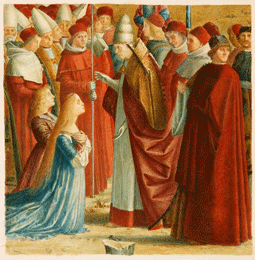'St Ursula receiving the Pope's Benediction', after Carpaccio
Charles Fairfax Murray (1849-1919). Watercolour and bodycolour on paper, 1877.
WorkThis watercolour shows a small portion of a painting that is one of a series of nine. Together they unfold the story of St Ursula. Charles Fairfax Murray copied a number of these details from original large-scale paintings by the Venetian artist Vittore Carpaccio (about 1460-1526). Carpaccio produced this cycle of paintings in tempera (an oily paint), between 1490 and 1496 for the Confraternity of St Ursula in Venice. Today these paintings are still in Venice, and are displayed in the Accademia Gallery.This detail is from the sixth painting in the series. In the sixth painting, the kneeling figure of St Ursula is at the centre, next to her fiancé, an English prince. A long procession of women is to her left and a procession of bishops to the centre and right. A large castle is in the background. The work describes a scene in Rome where Ursula meets the Pope.
St UrsulaThere are several versions of St Ursula's life-story. Carpaccio used the Legenda Aurea or Lives of the Saints, published in Venice in 1475 as inspiration for his paintings. St Ursula was a Christian princess, who lived in the third or fourth century AD. She agreed to marry a pagan prince on the condition that he first accompanied her and 11,000 virgins on a pilgrimage across Europe to Rome. At Rome, Pope Cyriacus joined Ursula's pilgrimage. On her return home, she had a vision of an angel who foretold her martyrdom. The prophecy was realised when Ursula and her attendants reached Cologne. Here the Huns, who had invaded from Asia and eastern Europe, attacked and murdered Ursula and all her attendants. ArtistCharles Fairfax Murray (1849-1919) made almost 40 copies of Italian masterpieces for the Guild of St George. He was a well-known figure in the late Victorian art world.He began his artistic career by drawing diagrams in a railway engineer's office. In 1866 he became an assistant to Edward Burne-Jones before becoming a designer and painter for the William Morris firm. Collection of the Guild of St George, Museums Sheffield
Ruskin provided Murray with further artistic education and in 1873 sent him to Italy to copy works by Botticelli. After starting a family in Florence, Murray worked in Italy until 1886 when he returned to work in London.In his 'Master's Report: 1884', Ruskin identifies Murray as the 'most skilful' of the artists employed in the task of copying endangered Italian buildings and art. He notes that 'the sketches we possess by his hand, from Carpaccio and Botticelli, are among the principal treasures we can boast at Oxford and Walkley' (Works, 30, p. 72).Despite his skill as a draughtsman, Murray was by the end of his life more famous as an art collector and dealer.
Ruskin on the St Ursula cycleRuskin first took note of the St Ursula paintings because he admired the work of Vittore Carpaccio. Ruskin admired Carpaccio's use of colour and attention to detail. Although Carpaccio painted historical scenes, the figures, architecture and backgrounds are those that would have been familiar to Carpaccio as a Venetian. The artist painted what he could see rather than what he imagined.Ruskin also saw St Ursula as a symbol of female purity and beauty and discussed her story in relation to Christian theology. In his later years, especially in times of mental illness, Ruskin came to link the paintings and the life of St Ursula with Rose La Touche, the love of his life. Rose died prematurely, possibly of anorexia. Ruskin found both comfort and grief in the images of Ursula and looked in them for spiritual messages from Rose. |



















